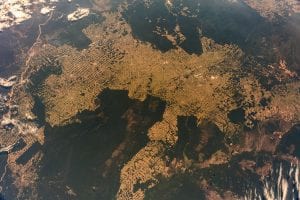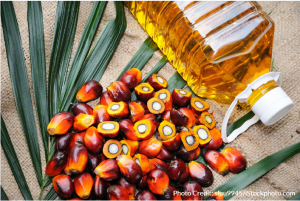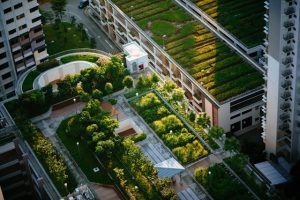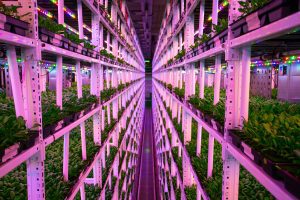Our society is presently faced with the challenge of sustainably scaling up the amount of food produced while considering the environmental impacts of this increase, especially on forests. In this blog, we will examine the globalized agriculture systems that have caused forest loss as well as solutions to address sustainable food production.
Historic Land Use and Population

Forests are a refuge – not just for our minds and spirits, but also for animals, plants, and our ecosystem as a whole. Unfortunately, in the past 10,000 years, humans have cut down one-third of all forests that covered the planet. This is about 2 billion hectares, or 8 million square miles of lost forest, which is roughly equivalent to twice the size of the continental U.S. Research has uncovered that the largest driver forest loss today is agriculture.
Advances in farming have paved the way for modern life, feeding a global population that has grown from 1 billion to 8 billion in just over 200 years. But these advances have not come without a cost – our current systems of agriculture continue to transform the world’s forest cover into crop and grazing land, where around 41 million trees are cut down each day for this purpose.
Agricultural Expansion and Deforestation
In today’s world we live with commodified and systemized agriculture productions. In some parts of the world, this means a supply of virtually anything we want, at any time. Beef, soy, and palm oil are the leading causes of agricultural-based deforestation. Annually, 27 million acres of forest is lost to agriculture use, with much of this occurring in the tropical rainforests of Indonesia and Brazil.

Indonesia is the world’s top supplier of palm oil and, in 2023, increased the amount of deforested land dedicated to palm oil plantations for the second year in a row. Palm oil is one of the world’s most widely used vegetable oils. While palm oil is found in many of our everyday products like cosmetics and cleaning agents, it’s also a common ingredient in many processed foods and animal feeds.
In the Brazilian Amazon, deforestation occurs largely as a result of beef production. Nearly 3,000 soccer fields of Amazon rainforest are cut each day with almost 70% of this land being used for cattle grazing. The demand for meat that fuels the expansion of grazing land is global: China is the world’s largest importer of beef and continues to drive deforestation in Brazil. Furthermore, largescale U.S. suppliers of beef such as JBS have admitted to purchasing cattle on illegally deforested land in the Amazon.
Whether in Indonesia or the Amazon, deforestation is associated with soil erosion, climate change, biodiversity loss, and flooding, not to mention loss of critical animal habitats. So why does the agricultural footprint continue expanding when we are aware of its detrimental impacts on the environment? We cannot ignore the impacts of a growing population, and the increased pressure this places on our agricultural systems. Modern systems of globalization and capitalism have driven many corporations to prioritize profit over the planet, but there is a growing movement that aims to change this status quo.
Feeding the Future with 5 Sustainable Agriculture Solutions
Looking ahead, as the world’s population is expected to reach 9.8 billion in 2050, farmers will need to produce 70% more food in order to meet the demands of hungry people. The big question is, how can we feed a larger population while minimizing the impact it has on the world’s forests?
Drawing on the wisdom from ancient practices that originated with Indigenous people from around the world, a new movement of sustainable and regenerative agriculture aims to bring life back to soil and address food production in a sustainable way. One of the critical pieces of this movement as it relates to forest conservation are the farmers attempting to implement regenerative techniques. Regenerative farming techniques bring people closer to their sources of food and steward local ecosystems.
The five sustainable agriculture solutions below offer a glimpse into some of the innovations and technologies that are emerging to restore the health of our soil, forests, and communities. A single solution is not the answer, but rather a combination of approaches tailored to specific regional and community needs. (We recognize that many indigenous communities have practiced sustainable land stewardship for centuries, but their stories, knowledge and connection to the land have been oppressed and eradicated by colonizers.)
1. Urban Farms
About 56% percent of the world’s population lives in cities, with the urban population expected to double in size by 2050. Shipping food from farms all over the world to cities contributes to deforestation and greenhouse gasses, and often decreases the quality and nutritional value of food. In an otherwise crowded and human-made environment, urban farms offer a space for people to grow their own food, sell it at farmers markets, and compost it for use as fertilizer on crops. This is a win-win all around as it reduces the demand for cutting down forests while connecting people to land, utilizes underused urban areas, and increases green space, air quality and food resilience in urban communities.

2. Food Forests
A food forest is a method of gardening that mimics the structure of a natural ecosystem, working with the land to create self-sustaining systems that produce food. Unlike annual plants which die in the winter, perennials grow back each year and provide protection from erosion while improving soil structure. Food forests can be planted in urban or rural areas and often include hardy, native perennial fruit, nut and berry trees/shrubs. The design mimics the symbiotic relationships of different layers in a forest. In the mid-Atlantic U.S., for example, a food forest might include paw paw trees, hazelnut, elderberry, persimmons, prickly pear, eastern huckleberry, etc. This method of food cultivation can help to redirect traditional deforestation of land for agriculture use and redesign it into a space that considers the existing ecosystem and provides food nearly year-round without the damages of conventional agriculture.
3. Vertical Farming
Vertical farming maximizes space and resources by doing exactly what it sounds like—growing upwards. This strategy of farming is particularly useful in urban areas, but can also be adopted anywhere in the world to reduce the amount of land that is deforested for agriculture. There are a number of downsides to this system, including high energy inputs and limited number of crops that can be grown in this style. However, it is still a valuable innovation that can become more feasible as we transition to renewable energy and work to minimize our agricultural expansion into forests.

4. Hydroponics
Another innovation in farming is hydroponics, or the practice of growing food in water instead of soil. Given that 70% of our global water supply is used for agriculture purposes, hydroponics, especially when combined with vertical farming, offers an innovative solution to food production to that conserves water and grows food without degrading the land. Hydroponic growing often happens in a controlled environment where nutrients in the water are consistently measured while lighting, heat, and humidity is controlled. It can offer the benefit of reducing the risk of disease and pests that often live within soils, which would help increase the resiliency of food production in future years while minimizing its agricultural footprint.
5. Cut Down on Meat Consumption
Ever heard of meatless Mondays? While nobody likes being told what to eat and when, it is undeniable that clearing land for livestock grazing accounts for roughly 40% of all deforestation. Specifically, beef production takes the highest toll on deforestation as it requires a large amount of land to be cleared for these animals to graze. Between 2001 and 2015, the beef industry converted 45.1 million hectares (111 million acres) of forest into pastures, which was a rate 2.5 times higher than conversion of forest land for palm oil and soybean production combined. Additionally, as 36% of all crops are grown for animal feed, even just trying to be more mindful about your red meat consumption can make a difference in reducing the demand for deforestation.
Conclusion
As we have become increasingly disconnected from our food systems, it is easy to overlook or ignore the impacts of agriculture on the world’s forests. The rate at which forest land is being cut down and converted to pastures or crop land is not only alarming, but unsustainable. Large corporations are fueled by consumer demands and incentivized with government subsidies to continue deforestation and agricultural expansion. However, there are still alternative solutions that we can embrace to save our forests. By fostering connection to the Earth through the stewardship of land while focusing our efforts on the production of locally grown, plant-based food, we can make a difference. In addition to supporting local farmers, regenerative agriculture, and reforestation efforts, Congress is considering the FOREST act, which aims to keep illegally deforested products from entering the U.S. Together, we can work towards a more sustainable future where the health of our soil is restored, forests are saved, and food is more equitably distributed to all.
Image credits: Aerial view of deforestation (Amazon rainforest by Alexander Gerst is licensed under CC BY 2.0); Palm oil (ID 483563566 by slpu9945); Urban Farm (CHUTTERSNAP on Unsplash); Growing spinach with vertical farming (Photo by Petr Magera on Unsplash)


